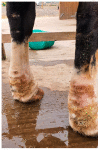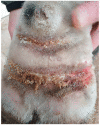Chronic Progressive Lymphedema in Belgian Draft Horses: Understanding and Managing a Challenging Disease
- PMID: 37235431
- PMCID: PMC10222719
- DOI: 10.3390/vetsci10050347
Chronic Progressive Lymphedema in Belgian Draft Horses: Understanding and Managing a Challenging Disease
Abstract
Chronic progressive lymphedema (CPL) in draft horses is characterized by increased dermal thickness and fibrosis, with the development of skinfolds and nodules, hyperkeratosis, and ulcerations on the distal limbs of affected horses. Secondary bacterial, fungal, or parasitic infections frequently complicate and aggravate the lesions, as well as the progression of this disease. CPL has a particularly high prevalence of up to 85.86% in the Belgian draft horse breed. Due to the disease's progressive and incurable nature, affected horses are often euthanized prematurely. The treatment options are solely symptomatic, aimed at improving the horse's quality of life. Despite the severity of this condition, many uncertainties about its etiology and pathogenesis still remain to date. The established scientific research on CPL is rather limited, although there is an urgent need for strategies to tackle this disease. This review summarizes the available knowledge, serving as a guideline for practitioners, and provides perspectives for future research programs.
Keywords: Belgian draft horse; clinical signs; elastin; fibrosis; hyperkeratosis; lymphedema; pathogenesis; skinfolds; treatment.
Conflict of interest statement
The authors declare no conflict of interest.
Figures

















References
-
- Schutzer E. Ph.D. Thesis. Medizinische Fakultät der Universität Leipzig; Leipzig, Germany: 1909. Ein Beitrag zur Kenntnis der Dermatitis Chronica Verrucosa (Sogenannter Straubfuss)
-
- Gustine G. Ph.D. Thesis. Vereinigte Medizinische Fakultät der Groβherzöglichen Hessischen Ludwigs-Universität zu Gieβen; Gieβen, Germany: 1910. Die Sogenannte Warzenmauke des Pferdes “Dermatitis Chronica Verrucosa”.
-
- Wussow W., Hartwig W. Die Zuchtverwendungsdauer der Beschäler des Landgestüt Kreuz und ihre Abgangsursachen. Tierzucht. 1954;10:336–342.
-
- Ferraro G.L. Chronic progressive lymphedema in draft horses. J. Equine Vet. Sci. 2003;23:189–190. doi: 10.1053/jevs.2003.56. - DOI
Publication types
LinkOut - more resources
Full Text Sources

